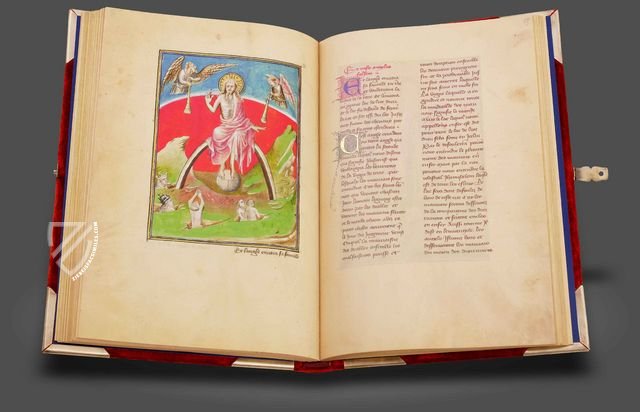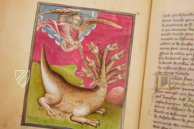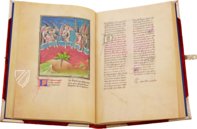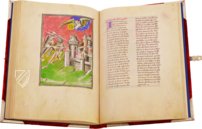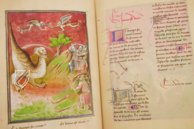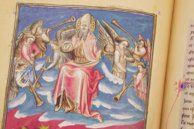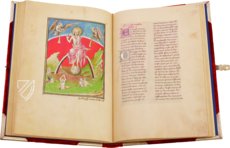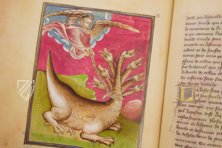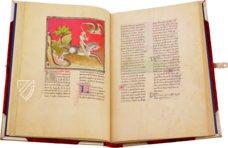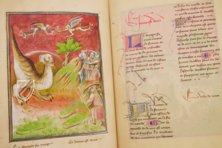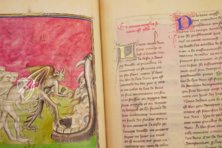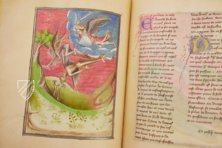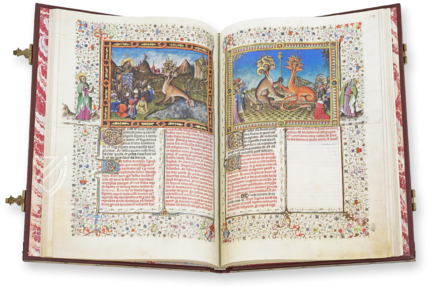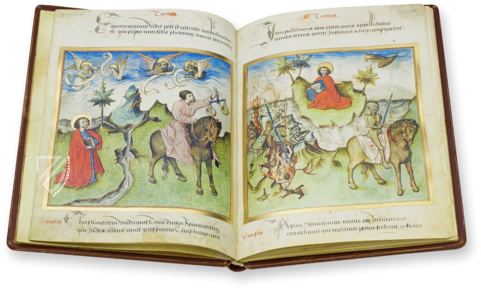Berry Apocalypse
(3,000€ - 7,000€)
This masterpiece of early 15th century Parisian book art comes from the hand of the so-called Master of the Berry Apocalypse. His style of illumination was unique among contemporaries and is distinguished inter alia by an understated but skillful use of color and shading as well as concentrating on events in the foreground. The Berry Apocalypse was likely commissioned ca. 1410 by the famous bibliophile Duke John of Berry and passed through the hands of various collectors before it found its final repository in New York’s famous Morgan Library. 85 large miniatures adorn the text, which consists of excerpts from the Book of Revelation in addition to a commentary by the Benedictine monk Berengaudus.
Berry Apocalypse
Made in Paris ca. 1410 for the famous bibliophile Duc Jean de Berry (1340-1416), this splendid Apocalypse manuscript contains excerpts from the text of the Book of Revelation in addition to a commentary by the Benedictine monk Berengaudus (840-892) adorned by 85 half- or full-page miniatures. Its text is written in two columns by an elegant hand with Bastarda script and elegant red-blue initials. The color palette of the miniatures is dominated by red, blue, and green, often with monochrome backgrounds and gold leaf has been employed for halos, crowns, and some initials. Stylistically unique and focusing clearly on characters and events, the miniatures possess a dramatic expressiveness, dramatic iconography, and an explicit relationship to the text. At the same time, they have a dreamlike quality with artful vegetation and realistic architectures. All of this comes together to form an artistically unique manuscript of the Apocalypse tradition.
Master of the Berry Apocalypse
The anonymous French illuminator responsible for the manuscript is known as the Master of the Berry Apocalypse. Evidence of his hand has been identified in several other works, including the secular Histoire Ancienne, a French translation of the world history Historiae Adversus Paganos written by the Roman priest, historian, and theologian Paulus Orosius (d. ca. 420), and a richly illuminated Bible Historiale. His style is distinguished from his Parisian contemporaries by a quick, sketchier execution and skillful use of colder and paler colors. Some images in his works are small sketches in shades of brown that are only partially lightly colored and accented with black and white paint. The sky is often indicated only by a few blue strokes, and his simple landscape depictions rarely show figures or cities in the background in order to focus on the main events in the foreground. Although his true identity is not known, the Master of the Berry Apocalypse has been immortalized by this unique masterpiece.
Coveted by Bibliophiles
The association with the Duke of Berry comes from a partially erased inscription reading Ce libre est au Duc de Berry Jehan as well as a miniature depicting both John the Apostle and John the Baptist, both namesakes of the famous Duke. Furthermore, Jean lived through an apocalyptic period of the Middle Ages marked by famine, plague, war, and strife within the church. The terrifying events of the text would have been all too real for him, but the story of the ultimate triumph of good over evil must have been some consolation, especially at the end of the Duke’s life. After remaining in the ducal library in Berry until the 16th century, the manuscript was acquired by the Mauvoisin family, which is attested to by further inscriptions in the manuscript, and later passed to the family of the comtes de La Tour du Pin. It was sold in Paris in 1879 and again in 1881 when it was acquired by Theodore Irwin. The manuscript was acquired in 1900 along with the rest of the Irwin collection in 1900 by the famous financier and philanthropist J. P. Morgan Jr. (1867-1943).
Codicology
- Alternative Titles
- Berry-Apokalypse
- Size / Format
- 174 pages / 30.2 × 20.8 cm
- Origin
- France
- Date
- 1400–1415
- Epochs
- Style
- Genre
- Language
- Script
- Littera bastarda
- Illustrations
- 85 full-page miniatures
- Content
- The Book of Revelation with the corresponding commentary from the text 'Expositio super septum visions in Apocalypsis' by the Benedictine monk Berengaudus
- Patron
- John, Duke of Berry (1340–1416)
- Artist / School
- Master of the Berry Apocalypse
- Previous Owners
- John, Duke of Berry
Malvoisin family
Comtes de la Tour du Pin
J. F. A. du Puget comte de Nadaillac
Ellis and White
Theodore Irwin
John Pierpont Morgan Senior
Berry Apocalypse
The Throne of God
In Revelation 4, John describes seeing God enthroned and surrounded by 24 elders and 7 lamps before introducing the four living creatures, who are also associated with the Four Evangelists. They are depicted here with golden halos in each of the four corners looking toward the center, where God is framed by a mandorla. Crowned with a Papal tiara and a golden halo, He makes the sign of benediction and holds a book. The crowned elders are seated around Him as though they were at a table.

Berry Apocalypse
The Beast from the Sea
“Then I stood on the sand of the sea. And I saw a beast rising up out of the sea, having seven heads and ten horns, and on his horns ten crowns, and on his heads a blasphemous name. Now the beast which I saw was like a leopard, his feet were like the feet of a bear, and his mouth like the mouth of a lion. The dragon gave him his power, his throne, and great authority.” (Rev. 13:1-2)
Standing under a blood red sky among a hilly landscape, the beast, labelled “Antecrist”, is presented with a book bearing one seal representing his power and authority by the wingless dragon, who is inscribed with “Deable”. The facial expressions of these monsters are far from menacing, one could easily imagine the artist modelling them on pets sitting nearby.
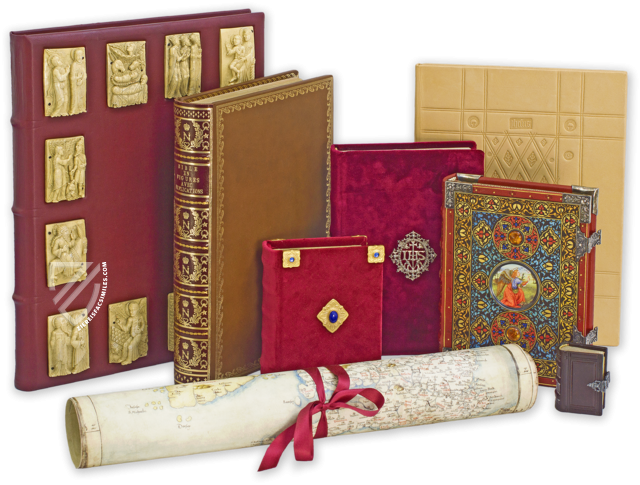
#1 Die Berry-Apokalypse
Languages: German, English
The academic commentary volume by Richard K. Emmerson contains explanations of the history and philological peculiarities as well as descriptions of all miniatures and initials of the original manuscript.
(3,000€ - 7,000€)
- Treatises / Secular Books
- Apocalypses / Beatus
- Astronomy / Astrology
- Bestiaries
- Bibles / Gospels
- Chronicles / History / Law
- Geography / Maps
- Saints' Lives
- Islam / Oriental
- Judaism / Hebrew
- Single Leaf Collections
- Leonardo da Vinci
- Literature / Poetry
- Liturgical Manuscripts
- Medicine / Botany / Alchemy
- Music
- Mythology / Prophecies
- Psalters
- Other Religious Books
- Games / Hunting
- Private Devotion Books
- Other Genres
- Afghanistan
- Armenia
- Austria
- Belgium
- Colombia
- Croatia
- Cyprus
- Czech Republic
- Denmark
- Egypt
- Ethiopia
- France
- Germany
- Greece
- Hungary
- India
- Iran
- Iraq
- Israel
- Italy
- Japan
- Lebanon
- Luxembourg
- Mexico
- Morocco
- Netherlands
- Palestine
- Peru
- Poland
- Portugal
- Russia
- Serbia
- Spain
- Sri Lanka
- Sweden
- Switzerland
- Syria
- Turkey
- Ukraine
- United Kingdom
- United States
- Uzbekistan
- Aboca Museum
- Ajuntament de Valencia
- Akademie Verlag
- Akademische Druck- u. Verlagsanstalt (ADEVA)
- Aldo Ausilio Editore - Bottega d’Erasmo
- Alecto Historical Editions
- Alkuin Verlag
- Almqvist & Wiksell
- Amilcare Pizzi
- Andreas & Andreas Verlagsbuchhandlung
- Archa 90
- Archiv Verlag
- Archivi Edizioni
- Arnold Verlag
- ARS
- Ars Magna
- ArtCodex
- AyN Ediciones
- Azimuth Editions
- Badenia Verlag
- Bärenreiter-Verlag
- Belser Verlag
- Belser Verlag / WK Wertkontor
- Benziger Verlag
- Bernardinum Wydawnictwo
- BiblioGemma
- Biblioteca Apostolica Vaticana (Vaticanstadt, Vaticanstadt)
- Bibliotheca Palatina Faksimile Verlag
- Bibliotheca Rara
- Boydell & Brewer
- Bramante Edizioni
- Bredius Genootschap
- Brepols Publishers
- British Library
- C. Weckesser
- Caixa Catalunya
- Canesi
- CAPSA, Ars Scriptoria
- Caratzas Brothers, Publishers
- Carus Verlag
- Casamassima Libri
- Chavane Verlag
- Christian Brandstätter Verlag
- Circulo Cientifico
- Club Bibliófilo Versol
- Club du Livre
- CM Editores
- Collegium Graphicum
- Collezione Apocrifa Da Vinci
- Comissão Nacional para as Comemorações dos Descobrimentos Portugueses
- Coron Verlag
- Corvina
- CTHS
- D. S. Brewer
- Damon
- De Agostini/UTET
- De Nederlandsche Boekhandel
- De Schutter
- Deuschle & Stemmle
- Deutscher Verlag für Kunstwissenschaft
- DIAMM
- Droz
- E. Schreiber Graphische Kunstanstalten
- Ediciones Boreal
- Ediciones Grial
- Ediclube
- Edições Inapa
- Edilan
- Editalia
- Edition Deuschle
- Edition Georg Popp
- Edition Leipzig
- Edition Libri Illustri
- Editiones Reales Sitios S. L.
- Éditions de l'Oiseau Lyre
- Editions Medicina Rara
- Editorial Casariego
- Editorial Mintzoa
- Editrice Antenore
- Editrice Velar
- Edizioni Edison
- Egeria, S.L.
- Eikon Editores
- Electa
- Emery Walker Limited
- Enciclopèdia Catalana
- Eos-Verlag
- Ephesus Publishing
- Ernst Battenberg
- Eugrammia Press
- Extraordinary Editions
- Fackelverlag
- Facsimila Art & Edition
- Facsimile Editions Ltd.
- Facsimilia Art & Edition Ebert KG
- Faksimile Verlag
- Feuermann Verlag
- Folger Shakespeare Library
- Franco Cosimo Panini Editore
- Friedrich Wittig Verlag
- Fundación Hullera Vasco-Leonesa
- G. Braziller
- Gabriele Mazzotta Editore
- Gebr. Mann Verlag
- Gesellschaft für graphische Industrie
- Getty Research Institute
- Giovanni Domenico de Rossi
- Giunti Editore
- Graffiti
- Grafica European Center of Fine Arts
- Guido Pressler
- Guillermo Blazquez
- Gustav Kiepenheuer
- H. N. Abrams
- Harrassowitz
- Helikon
- Hendrickson Publishers
- Henning Oppermann
- Herder Verlag
- Hes & De Graaf Publishers
- Hoepli
- Holbein-Verlag
- Hortus Deliciarum
- Houghton Library
- Hugo Schmidt Verlag
- Idion Verlag
- Il Bulino, edizioni d'arte
- ILte
- Imago
- Insel Verlag
- Instituto Nacional de Antropología e Historia
- Istituto dell'Enciclopedia Italiana - Treccani
- Istituto Ellenico di Studi Bizantini e Postbizantini
- Istituto Geografico De Agostini
- Istituto Poligrafico e Zecca dello Stato
- Italarte Art Establishments
- J. Thorbecke
- Jan Thorbecke Verlag
- Johnson Reprint Corporation
- Josef Stocker
- Josef Stocker-Schmid
- Jugoslavija
- Karl W. Hiersemann
- Kasper Straube
- Kaydeda Ediciones
- Kindler Verlag / Coron Verlag
- Kodansha International Ltd.
- Konrad Kölbl Verlag
- Kurt Wolff Verlag
- La Liberia dello Stato
- La Linea Editrice
- La Meta Editore
- Lambert Schneider
- Landeskreditbank Baden-Württemberg
- Leo S. Olschki
- Les Incunables
- Library of Congress
- Libreria Musicale Italiana
- Lichtdruck
- Lito Immagine Editore
- Lumen Artis
- Lund Humphries
- M. Moleiro Editor
- Maison des Sciences de l'homme et de la société de Poitiers
- Manuscriptum
- Martinus Nijhoff
- Maruzen-Yushodo Co. Ltd.
- MASA
- McGraw-Hill
- Militos
- Millennium Liber
- Müller & Schindler
- Nahar and Steimatzky
- National Library of Wales
- Neri Pozza
- Nova Charta
- Oceanum Verlag
- Odeon
- Orbis Mediaevalis
- Orbis Pictus
- Österreichische Staatsdruckerei
- Oxford University Press
- Pageant Books
- Parzellers Buchverlag
- Patrimonio Ediciones
- Pattloch Verlag
- PIAF
- Pieper Verlag
- Plon-Nourrit et cie
- Prestel Verlag
- Princeton University Press
- Prisma Verlag
- Priuli & Verlucca, editori
- Pro Sport Verlag
- Propyläen Verlag
- Pytheas Books
- Quaternio Verlag Luzern
- Reales Sitios
- Recht-Verlag
- Reichert Verlag
- Reichsdruckerei
- Riehn & Reusch
- Roberto Vattori Editore
- Rosenkilde and Bagger
- Roxburghe Club
- Salerno Editrice
- Sarajevo Svjetlost
- Schöck ArtPrint Kft.
- Scolar Press
- Scrinium
- Scripta Maneant
- Scriptorium
- Siloé, arte y bibliofilia
- SISMEL - Edizioni del Galluzzo
- Sociedad Mexicana de Antropología
- Société des Bibliophiles & Iconophiles de Belgique
- Soncin Publishing
- Sorli Ediciones
- Stainer and Bell
- Studer
- Styria Verlag
- Sumptibus Pragopress
- Szegedi Tudomànyegyetem
- Taberna Libraria
- Tarshish Books
- Taschen
- Tempus Libri
- Testimonio Compañía Editorial
- Thames and Hudson
- The Clear Vue Publishing Partnership Limited
- The Facsimile Codex
- The Folio Society
- The Marquess of Normanby
- The Richard III and Yorkist History Trust
- Tip.Le.Co
- TouchArt
- TREC Publishing House
- TRI Publishing Co.
- Trident Editore
- Typis Regiae Officinae Polygraphicae
- Union Verlag Berlin
- Universidad de Granada
- University of California Press
- University of Chicago Press
- Urs Graf
- Vallecchi
- Van Wijnen
- VCH, Acta Humaniora
- VDI Verlag
- VEB Deutscher Verlag für Musik
- Verlag Anton Pustet / Andreas Verlag
- Verlag Bibliophile Drucke Josef Stocker
- Verlag der Münchner Drucke
- Verlag für Regionalgeschichte
- Verlag Styria
- Vicent Garcia Editores
- W. Turnowsky
- Waanders Printers
- Wiener Mechitharisten-Congregation (Wien, Österreich)
- Wissenschaftliche Buchgesellschaft
- Wydawnictwo Dolnoslaskie
- Xuntanza Editorial
- Zakład Narodowy
- Zollikofer AG

